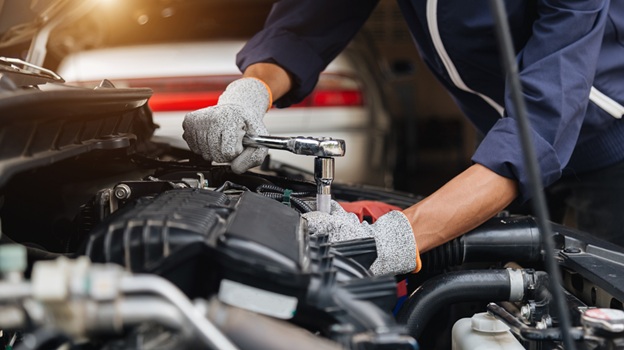Cooling capacity on a trail rig isn’t just about radiator size or fan CFM—it’s about how much clean air actually reaches the core. Add armor, recovery gear, lights, and styling touches, and you can unknowingly build a wall in front of the radiator, condenser, intercooler, and trans cooler. If your temps creep on long climbs or when crawling in summer, look for these eight airflow killers—and the fixes that keep coolant temps in the green.
1. Overbuilt, Under-vented Front Bumpers
Heavy steel bumpers are fantastic for protection and recovery points, but solid center sections block the highest-pressure air stream. Without generous cutouts and internal ducting, the bumper turns ram air into a dead zone.
Fix: Choose bumpers with large, louvered openings aligned to the radiator’s center mass. Add internal shrouds that guide air through the cooling stack, not around it. If you already own a solid-face bumper, consider precision cutouts with gusseting to restore flow without losing strength.
2. Winch + Fairlead “Wall”
A high-mount winch, thick fairlead, and bulky hook can sit exactly where airflow is most valuable. The drum and rope become a heat sink and a blockage, especially with synthetic line stacked high.
Fix: Drop the winch lower in the bumper pocket, switch to a hawse fairlead with a radiused profile, and stow the hook or soft shackle away from the opening. Keep the first wraps tight and low on the drum to reduce the “roll” height in the airstream. Vent or louver the bumper’s upper lip to relieve stagnation.
3. Light Bars Perched in Front of the Grille
A 20–50″ bar can act like a spoiler at the worst possible spot, tripping flow right before it should compress into the grille. Multiple cube pods do the same when clustered tightly.
Fix: Roof- or cowl-mount long bars; if grille-mount is required, recess the bar behind the grille plane. Space pods apart vertically and horizontally so air can pass between them. Use slimmer housings with finned backs that sit below the grille’s centerline.
4. License Plates, Badges, and Plate Brackets
It sounds trivial, but a centered plate and thick bracket can create a surprising wake right where the radiator wants smooth pressure. Add a front-facing camera housing and you’ve built a turbulent cluster.
Fix: Offset the plate to one side with a low-profile mount or quick-release bracket for trail days. Smooth the bracket’s leading edge and avoid stacking accessories in one spot.
5. Dense Mesh Grilles and Decorative Inserts
Aftermarket meshes look great and block debris, but tight weaves reduce mass flow, especially at crawling speeds where the fan must pull air through every layer.
Fix: Choose high-flow mesh (larger open area percentage) or remove the mesh directly in front of the radiator’s core while keeping it over lesser-critical openings. Pair with a full fan shroud and seal the grille-to-radiator gaps with foam to force air through the fins.
6. Stacked Coolers with No Spacing
A/C condenser + trans cooler + power-steering cooler + intercooler stacked tight equals heat soak. Each core warms the next, and without spacing or ducting, the fan fights to pull air through a hot brick.
Fix: Stagger coolers with at least 0.5–1.0″ air gaps and use offset mounting rails to encourage crossflow. When possible, relocate auxiliary coolers to a high-flow fender duct with a dedicated pusher/puller fan. Seal the perimeter so air can’t bypass the stack.
7. Skid Plates and Belly Pans That Trap Air
Full belly armor is great for rocks, but if the front lip seals the underside and the rear has no exit, you’ve built a pressure pocket. The fan works, but the hot air has nowhere to go, recirculating under the nose.
Fix: Incorporate louvered exits behind the radiator and at the rear of the front skid. Use NACA ducts and deflectors that evacuate air toward low-pressure zones under the cab. Ensure the lower radiator air dam (if equipped) is intact to help create a pressure differential.
8. Poor Sealing Around the Radiator and Shroud
Even with a big fan, gaps around the radiator, broken shroud tabs, or missing foam seals let air take the path of least resistance—around the core instead of through it.
Fix: Replace missing seals, add foam tape to close side gaps, and confirm the shroud fully encircles the fan blade arc. On electrics, ensure the shroud pulls across the whole core (not just a small circle over the fan). On mechanical fans, verify the blade sits half-in/half-out of the shroud opening for best draw.
Testing and Tuning: Make Airflow Measurable
- Temp deltas: Compare coolant temp at speed vs. in a slow climb; a big spread hints at airflow limits.
- Infrared scan: After a pull, scan the radiator face; cold stripes indicate blockage.
- Tuft test: Tape yarn tufts around the grille/bumber and film at speed to visualize detachment and recirculation.
- Fan audit: Verify commanded RPM and CFM; a high-capacity radiator can’t help if the fan underperforms.
Build a Cooling-First Accessory Plan
- Map the core area and keep it as open as possible.
- Recess or relocate mass (winch, lights) out of the center stream.
- Use ducting and seals so every cubic foot the fan moves goes through fins.
- Vent armor and skids to give hot air an exit path.
- Re-test after every front-end modification.
Airflow is the cheapest horsepower you can buy for your cooling system. When you design the front end with the radiator in mind—and give hot air a clean way out—temps stabilize on long grades, A/C stays cold at low speed, and the driveline lives longer. If your rig still runs hot after these changes, it may be time to pair airflow fixes with higher-capacity components and a professional system check. Shops that specialize in cooling and heating repair for 4×4 can pressure-test the system, verify fan performance, and recommend the right combination of radiator, shroud, and ducting for your setup.

